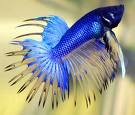Breeding Betta Fish - An Essential Guide
When you decide to breed your Betta Fish, the first step is to make sure you are ready. It will take time, money, space for around fifty jars to separate males, a secure pond with no other fish and a good level of experience caring for Bettas already.
Presuming the answer is yes; the next step is to obtain a female. This can be difficult, as few stores sell them. Once you have both, don’t leave them in the same tank. Start with cheap Bettas, to avoid wasting lots of money. Later on, after you become an expert, you can try to breed your own masterpieces. Look for fish with some energy to increase the chances of spawning. The chosen fish should be between seven and eighteen months old, and a spare pair just in case is also a wise precaution.
Prepare the mating tank, ten gallons is about right. Don’t add much decorations or gravel, but some large leafed plants will help the female hide from the male. The temperature should be around eighty degrees and the depth about six inches until the fry, or baby fish, begin swimming. Normally, you wouldn’t worry about air filtration with Bettas, but the fry will require it. However, they cannot handle a powerful filter. The old-fashioned box type, powered by an air pump is best, and the carbon filter that came with the pump is not acceptable. Instead, use floss or sponges. This is to avoid bad reactions between the carbon and an anti-fungal treatment. It is wise to let the pump operate through a complete cycle before fish are exposed to it to allow bacteria to grow.
Begin feeding the fish high quality food. One breeder recommends the following sequence: BettaMin, Freeze Dried Blood Worms, some live or frozen brine shrimp, then a few live Black Worms. Others swear by tubifex worms and other combinations. Do not overfeed, as this will still force you to clean the tank and replace the water more often. Change twenty percent of the water in each tank each day to help prevent this and encourage the fish to get ready to breed. The male should be in the breeding tank, and should be able to see the female in her tank. He should begin to build a bubble nest.
With the high quality food, the female should begin to plump up as eggs are produced. With lighter colored breeds you can sometimes see the eggs, and the fish should produce horizontal stripes when ready. If that isn’t showing, look near the anal fin for a white gravid tube. If this is showing, she is ready.
Now comes the key moment. Plan for at least an hour when you can be present to supervise. Put the female in the water with the male. There can be some rough treatment, including some mutual fin nipping or even worse behavior. If it gets too rough, remove the female and plan to wait a few days to let her recover, but if you don’t give them a chance, there won’t ever be any fry. If all goes well, they will conduct what is called an embrace, and she will produce eggs under the bubble nest. He will fertilize them and begin to care for the eggs. The female should be removed now, lest she become fish food.
For the next two days, the male will keep the eggs cleaned and in the bubble nest, recovering any that fall. Then come the fry. For about thirty-six hours, they’ll be unable to move out of the tank. Around two days after hatching, the first fry will begin to swim without help. At this point, remove the male fish lest the fry become fish food. A day after the fry hatch, they need their first feeding, and baby brine shrimp, daphnia, microworms, or liquid fry food for egg layers are good choices. They’ll need feeding up to five times a day.
Now comes the hard part. Many experienced breeders say this can only be done in a suitable pond. The temperature must be above at least 68 and preferably 70 degrees. There must be no fish to eat the fry, and a variety of tiny aquatic creatures to eat.
After about ten days, they can take a little powdered food. This is a small amount of very finely crushed flake food. They should be about a quarter of an inch long. At about four weeks, they should be around a half inch long, and should begin to show sexual dimorphism, so you can tell the males from the females. Separate the males from each other before fighting begins.
Sarah Munn is an animal lover, and currently own 7 pets (including her Betta fish, Margo). Sarah is a freelance author and editor, most recently editing the popular e-Book. "Betta Care Made Easy." Sarah would like to recommend the Betta Fish Care Newsletter as the best place to learn more about betta fish care.
Article Source: http://EzineArticles.com/?expert=Sarah_Munn



